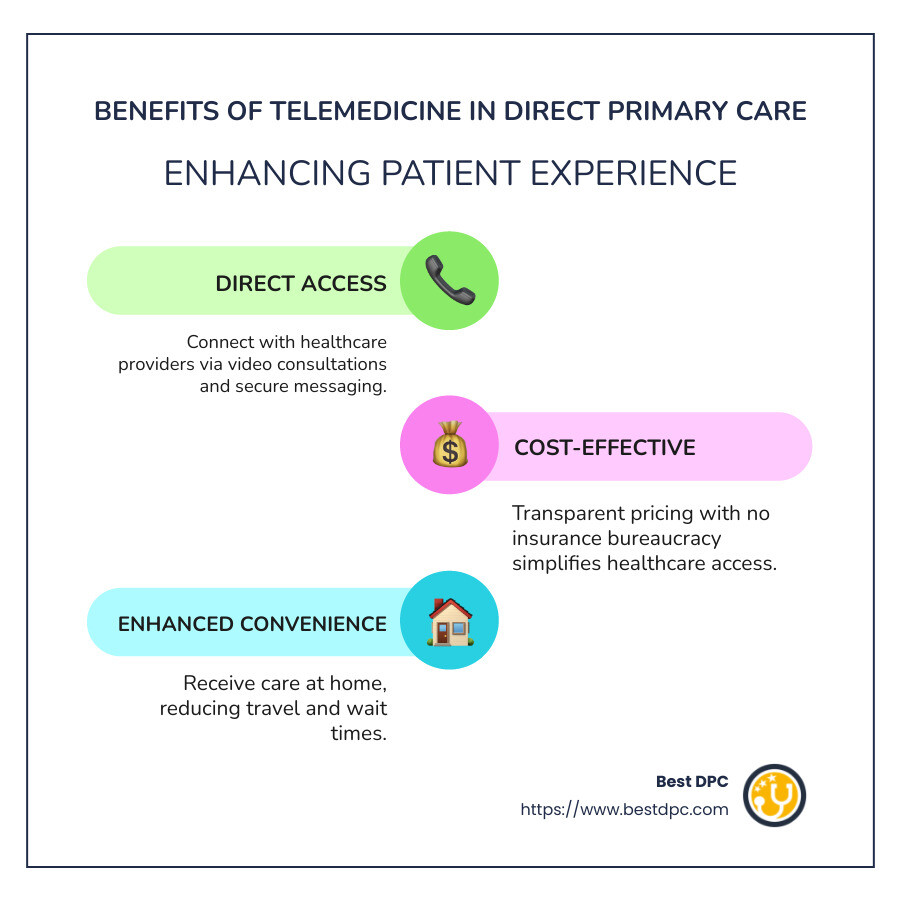Wayne Lowry

Telemedicine options in direct primary care are changing how patients access healthcare services, making them more accessible and affordable than ever before.
In recent years, more people have been seeking alternatives to the often frustrating traditional healthcare system. Long wait times, high costs, and complex processes can overwhelm those with chronic conditions or urgent needs. That’s where telemedicine comes in, providing solutions that are both accessible and affordable.
Direct Primary Care (DPC) accepts telemedicine by offering a subscription-based model. Patients pay a regular fee to access comprehensive care without the clutter of insurance bureaucracy. This approach not only simplifies healthcare access but also improves the patient-doctor relationship. By combining DPC with telemedicine, individuals can receive personalized, continuous care whenever and wherever they need it.

Understanding Direct Primary Care
Direct Primary Care (DPC) is a refreshing take on healthcare that simplifies the way you access medical services. Think of it as a subscription service, like Netflix, but for your health. You pay a monthly fee, and in return, you get direct access to your primary care provider. No more dealing with complex insurance paperwork or unexpected bills.
The DPC Model: A New Way to Access Healthcare
Why DPC Works
DPC is about making healthcare more personal and less stressful. Patients can easily schedule appointments, and often, they can see their doctor the next day. This is especially helpful for people with chronic conditions who need regular check-ins.
In many cases, DPC practices have shown success in improving patient health outcomes. For instance, a rural DPC practice significantly cut down wait times and improved patient satisfaction by offering next-day visits. Patients reported feeling more in control of their health due to the continuous and personalized care they received.
A Win-Win for Patients and Doctors
For doctors, the DPC model means less time spent on insurance paperwork and more time with patients. This can lead to a more satisfying work environment and better patient care.
By focusing on a subscription model, DPC practices can offer more personalized and accessible care, making it a win-win for both patients and healthcare providers. And when combined with telemedicine, the DPC model becomes even more powerful, offering care that’s both convenient and comprehensive.
Telemedicine Options in Direct Primary Care
Virtual Direct Primary Care (DPC) is changing how patients access healthcare. It’s like having a doctor’s office in your pocket. With telehealth services, you can consult your doctor from anywhere—be it your living room or even while traveling.
Remote Consultations Made Easy
Gone are the days of sitting in waiting rooms. With virtual DPC, you can schedule remote consultations via video calls or phone. This means you can speak to your doctor without having to leave your home. It’s especially beneficial for those with mobility issues or a busy schedule.
Managing Chronic Diseases
Managing chronic diseases is a key part of DPC. Virtual DPC makes it easier to keep track of conditions like diabetes or hypertension. Regular check-ins with your doctor can be done virtually, ensuring that your health is monitored closely without frequent trips to the clinic.
Telehealth Services: What’s Included?
The Power of Telemedicine in DPC
Telemedicine improves the DPC model by making healthcare more accessible and efficient. It reduces travel time and costs, and allows for more frequent interactions with your healthcare provider. This leads to better health outcomes and higher patient satisfaction.
Telemedicine options in direct primary care offer a modern solution to healthcare, combining the benefits of technology with the personalized care of DPC. This integration ensures that patients receive comprehensive care, whether it’s for routine check-ups or managing long-term conditions.
Advantages of Telemedicine in Direct Primary Care
Telemedicine is changing the way we think about healthcare, especially within the Direct Primary Care (DPC) model. It brings several advantages that make healthcare more patient-friendly and effective.
Convenience at Your Fingertips
Imagine needing to see your doctor and being able to do so without leaving your home. That’s the convenience telemedicine brings to the DPC model. Whether you’re at home, at work, or traveling, you can have a consultation with your doctor through a simple video call or phone conversation. This is particularly helpful for those with busy schedules or mobility challenges.
Cost Savings for Everyone
Telemedicine in DPC can save money for both patients and providers. By reducing the need for physical office visits, patients save on travel costs and time off work. Providers can operate more efficiently, which often translates into lower costs for patients. In fact, using telemedicine can help approach the same 20-30% savings on healthcare expenditures seen with traditional DPC, making it a cost-effective option for many.

Continuity of Care
One of the most significant benefits of telemedicine in DPC is the continuity of care. Patients connect with the same primary care doctor each time, which means the doctor is familiar with their medical history and unique health concerns. This ongoing relationship ensures that care is consistent and personalized, leading to better health outcomes.
Chronic Condition Monitoring Made Simple
Managing chronic conditions like diabetes or hypertension becomes easier with telemedicine. Patients can have regular check-ins with their doctor without the hassle of frequent clinic visits. Tools like remote patient monitoring allow doctors to track vital health data in real time, making it easier to manage and adjust treatment plans as needed.
Telemedicine options in direct primary care are not just about convenience—they are about improving the overall healthcare experience. They offer a seamless, efficient, and personalized approach to managing health, especially for those with chronic conditions.
Next, let’s explore the key features that make telemedicine in DPC so effective.
Telemedicine Options in Direct Primary Care: Key Features
Telemedicine in Direct Primary Care (DPC) is changing how patients interact with healthcare providers. Here are some of the key features that make this possible:
Live Video Conferencing
Imagine sitting in your living room and having a face-to-face conversation with your doctor. That’s what live video conferencing offers. This feature allows patients to have real-time consultations with their primary care physician, providing a personal touch without the need for travel. It’s perfect for discussing symptoms, getting medical advice, or even receiving a diagnosis for certain conditions.
Remote Patient Monitoring
Remote patient monitoring is like having a virtual nurse keeping an eye on your health. Patients can use devices that track vital signs such as blood pressure, glucose levels, or heart rate from home. This data is sent directly to their doctor, allowing for continuous monitoring of chronic conditions. It helps doctors make timely decisions about treatment adjustments, improving patient outcomes.

Mobile Health (mHealth)
Mobile health, or mHealth, refers to healthcare services accessed through mobile devices like smartphones or tablets. With mHealth apps, patients can schedule appointments, receive reminders, and access medical records. These apps also offer educational resources to help patients manage their health better. It’s healthcare in your pocket, making it easier to stay on top of your health.
Asynchronous Video
Asynchronous video provides flexibility for both patients and doctors. Patients can record a video of their symptoms or concerns and send it to their doctor at any time. The doctor can review the video and respond when convenient. This feature is particularly useful for non-urgent issues, saving time for both parties and allowing for thoughtful, thorough responses.
Each of these features improves the telemedicine options in direct primary care, making healthcare more accessible, efficient, and patient-centered. Let’s move on to frequently asked questions about telemedicine in DPC.
Frequently Asked Questions about Telemedicine in Direct Primary Care
Is telemedicine considered direct patient care?
Yes, telemedicine is absolutely considered direct patient care. It allows doctors to connect with patients in real-time, offering the same level of attention and personalized care as an in-person visit. Through telehealth services, patients can discuss their health concerns, receive diagnoses, and get treatment recommendations just like they would in a traditional office setting.
Can telehealth be used for primary care?
Definitely! Telehealth is a powerful tool for primary care. It lets patients access their primary care provider using digital platforms, making it easier to manage routine check-ups, chronic conditions, and preventive care. This approach is especially beneficial for people in remote areas or those who have mobility issues. According to research, telehealth can significantly improve care efficiency and flexibility, making healthcare more convenient for everyone.
What are the benefits of combining DPC and telemedicine?
Combining Direct Primary Care (DPC) with telemedicine offers numerous advantages:
In one case, a patient with chronic high blood pressure effectively managed their condition through regular video consultations with their DPC provider. This continuous care helped maintain their health and prevent complications, showcasing the power of personalized care through telemedicine.
These benefits highlight how telemedicine options in direct primary care can transform healthcare delivery, making it more patient-focused and efficient.
Conclusion
Best DPC is redefining healthcare by putting patients first. With a focus on affordability, accessibility, and personalized care, they are making healthcare more approachable for everyone. By integrating telemedicine with Direct Primary Care (DPC), they offer a seamless experience that fits into your life, not the other way around.
Affordability is a key factor. Patients pay a flat monthly fee, eliminating the complex and often costly insurance process. This makes it easier to plan for healthcare expenses without unexpected bills.
Accessibility is another cornerstone. Best DPC connects patients with their doctors through digital platforms, making it simple to access care from anywhere. Whether you’re in a remote location or just prefer the comfort of your home, telemedicine options in direct primary care mean your doctor is always within reach.
Personalized care is at the heart of what Best DPC offers. Patients enjoy a direct relationship with their provider, allowing for custom care plans that address both immediate and long-term health needs. This approach fosters trust and improves health outcomes by encouraging active participation in one’s own care.
For a healthcare experience that prioritizes you, explore Best DPC’s services. Your health, your way.

ABOUT AUTHOR
Wayne Lowry
Wayne Lowry, Founder of BestDPC, is a passionate advocate for Direct Primary Care (DPC) and its mission to deliver personalized, accessible healthcare. He believes that DPC providers should serve as the trusted first point of contact for all medical needs, ensuring patients never feel isolated or uncertain about their health decisions. Through his work, he champions a patient-first approach to healthcare, building a system that prioritizes guidance, support, and trust.

Thank You for Registering!
Your registration was successful! We're excited to have you on board. Please check your email for a confirmation link to complete your registration.